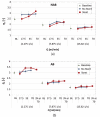The effects of stenting on hemorheological parameters: An in vitro investigation under various blood flow conditions
- PMID: 31006672
- PMCID: PMC7739967
- DOI: 10.3233/CH-180540
The effects of stenting on hemorheological parameters: An in vitro investigation under various blood flow conditions
Abstract
Despite their wide clinical usage, stent functionality may be compromised by complications at the site of implantation, including early/late stent thrombosis and occlusion. Although several studies have described the effect of fluid-structure interaction on local haemodynamics, there is yet limited information on the effect of the stent presence on specific hemorheological parameters. The current work investigates the red blood cell (RBC) mechanical behavior and physiological changes as a result of flow through stented vessels. Blood samples from healthy volunteers were prepared as RBC suspensions in plasma and in phosphate buffer saline at 45% haematocrit. Self-expanding nitinol stents were inserted in clear perfluoroalkoxy alkane tubing which was connected to a syringe, and integrated in a syringe pump. The samples were tested at flow rates of 17.5, 35 and 70 ml/min, and control tests were performed in non-stented vessels. For each flow rate, the sample viscosity, RBC aggregation and deformability, and RBC lysis were estimated. The results indicate that the presence of a stent in a vessel has an influence on the hemorheological characteristics of blood. The viscosity of all samples increases slightly with the increase of the flow rate and exposure. RBC aggregation and elongation index (EI) decrease as the flow rate and exposure increases. RBC lysis for the extreme cases is evident. The results indicate that the stresses developed in the stent area for the extreme conditions could be sufficiently high to influence the integrity of the RBC membrane.
Keywords: Cardiovascular stent; blood viscosity; lysis; red blood cell aggregation; red blood cell deformability.
Figures









Similar articles
-
An in vivo investigation on the effects of stent implantation on hematological and hemorheological parameters.Clin Hemorheol Microcirc. 2024;87(1):39-53. doi: 10.3233/CH-231921. Clin Hemorheol Microcirc. 2024. PMID: 38143339
-
Blood rheology during normal pregnancy.Clin Hemorheol Microcirc. 2018;69(1-2):101-114. doi: 10.3233/CH-189104. Clin Hemorheol Microcirc. 2018. PMID: 29758932
-
Hemorheological effects of secoisolariciresinol in ovariectomized rats.Biorheology. 2016 Jan 7;53(1):23-31. doi: 10.3233/BIR-15066. Biorheology. 2016. PMID: 26756280
-
In vivo correlates of altered blood rheology.Biorheology. 2008;45(6):629-38. Biorheology. 2008. PMID: 19065010 Review.
-
Disturbed blood flow structuring as critical factor of hemorheological disorders in microcirculation.Clin Hemorheol Microcirc. 1998 Dec;19(4):315-25. Clin Hemorheol Microcirc. 1998. PMID: 9972669 Review.
Cited by
-
In Vitro Evaluation of the Effect of Stenting on Hematological, Hemorheological and Hemodynamic Parameters, in Various Stent Configurations and Flow Conditions.Cardiovasc Eng Technol. 2025 Jun 25. doi: 10.1007/s13239-025-00791-0. Online ahead of print. Cardiovasc Eng Technol. 2025. PMID: 40563060
-
The association between stent design and patient exercise intensity: structural coupling effects and hemodynamic analysis.Front Bioeng Biotechnol. 2024 Dec 18;12:1514929. doi: 10.3389/fbioe.2024.1514929. eCollection 2024. Front Bioeng Biotechnol. 2024. PMID: 39744594 Free PMC article.
References
MeSH terms
LinkOut - more resources
Full Text Sources
Other Literature Sources

